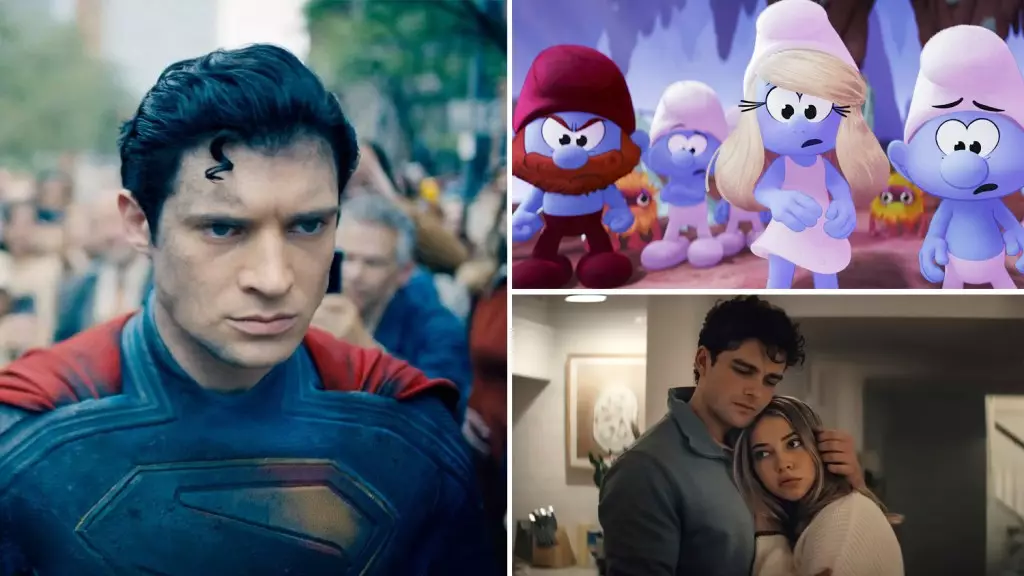This past weekend’s box office results lay bare a harsh reality for Hollywood: audiences are no longer willing to blindly support blockbuster mediocrity. While some studio insiders may sing praises of modest gains or resilient franchises, the truth is that the current theatrical landscape is a portrait of stagnation and shifting momentum. Superman’s latest outing, projected to earn around $16 million on its second Friday, exemplifies this decline. Its steep 71% drop from opening day signals a fundamental disconnection with moviegoers who demand more than recycled heroics and predictable spectacles. The projected second weekend total of approximately $55 million represents a disappointing high-end decline of 56%, underscoring the waning enthusiasm for such offerings.
This pattern isn’t isolated. Even high-profile titles like James Gunn’s “Guardians of the Galaxy Vol. 3” and Matt Reeves’ “The Batman” experience significant drops—each around 50-56%—highlighting the fragility of branded content when not paired with compelling storytelling. The fact that the biggest newcomers are battling to reach modest initial targets, such as “I Know What You Did Last Summer” with an expected $13-$15 million opening, reveals an audience increasingly resistant to predictable horror remakes and franchise fatigue.
The Fragmented Audience and Diminishing Returns for Traditional Studios
The traditional Hollywood model, reliant on star-driven franchises and blockbuster franchises, is visibly faltering. The once-reliable formula of sequel-driven hits like “Smurfs” and nostalgia reboots no longer guarantees box office supremacy. These films, often skewed toward children or core fan bases, are barely inching past the high single-digit or low double-digit millions, reflecting a marketplace that’s grown skeptical of derivative content. For instance, the latest “Smurfs” film’s projected $12 million opening is a far cry from its 2017 predecessor, which debuted to over $13 million. Given its wider international footprint and merchandise-driven revenue, studios are still eyeing the franchise’s future, but domestically, the appeal appears to be waning.
Meanwhile, “I Know What You Did Last Summer,” a franchise reboot with nostalgic roots from the late ’90s, faces a steeper challenge. Its modest previews—around $2.2 million—are revealing a fatigued audience. Despite the familiar cast returning, critics’ low ratings (38%) and a lukewarm audience reception (69%) illustrate that rehashing old horror tropes no longer guarantees success. The franchise’s previous entries, which once scored major openings upward of $15 million, are now relics of a bygone era.
Hollywood’s overreliance on franchise fatigue has created a paradox: audiences crave new experiences but reject the tired rehashes presented under familiar logos. The decline in opening numbers, along with increasing production costs, means studios are increasingly hitting diminishing returns, risking long-term profitability if the current trend persists.
Emerging Content and the Shift Toward Quality and Niche Audiences
The growing chasm between raw audience demand and studio output suggests a more fundamental crisis: the industry’s inability to produce compelling, original content that captures the consumer’s imagination. Notably, smaller films like A24’s “Eddington” and Aster’s “Hereditary” demonstrate that niche, writer-driven projects with strong critical support can outperform franchise fare—albeit on a smaller scale.
“Eddington,” a socio-political Western, earned only around $1.9 million in its opening weekend but showcases the potential of independent cinema to cultivate loyal viewers who seek authenticity over spectacle. Yet, even these smaller films struggle against the backdrop of middling franchises, revealing Hollywood’s failure to nurture genuine, diverse storytelling that resonates outside of limited niche markets.
The rise of streaming and the entertainment industry’s pivot away from theatrical dominance further diminishes the value of traditional franchises. Studios are beginning to understand that the audience for spectacle-driven blockbusters is shrinking, while viewers gravitate toward complex narratives, character-driven stories, and innovative genres available directly through digital platforms. This reality underscores a clear moral: Hollywood’s current reliance on recycled content and franchise loyalty is a short-term fix at best, and a hazardous long-term strategy.
The Bitter Truth: Audience Empowerment and The Road Ahead
The weekend’s numbers symbolize a shift of power from Hollywood studios to the movie-going public. Audiences are more discerning, rejecting the predictable and undervaluing the recycled franchise formula. High costs combined with lackluster engagement are forcing studios to confront their outdated assumptions about consumer interests.
It’s not mere cynicism; it’s a wake-up call. The industry’s obsession with leveraging existing IPs as safety nets is increasingly dangerous, especially when combined with rising production budgets that can’t be recouped in declining domestic markets. For Hollywood, the road ahead should involve embracing quality over quantity, investing in innovative storytelling, and respecting the intelligence of their viewers. If studios continue to prioritize lucrative franchises over genuine artistic innovation, they risk becoming relics of a bygone era, irrelevant to an audience that’s craving authentic, engaging cinema.
The current landscape isn’t just a dip in numbers; it’s a fundamental recalibration. Hollywood’s failure to adapt quickly and authentically to audience preferences will ultimately determine its survival or decline into a niche entertainment provider with diminishing influence. The days of unquestioned blockbuster dominance are over. The new era demands humility, creativity, and a genuine understanding that the future of cinema is in the hands of those willing to craft stories that resonate deeply with viewers—not just cash their royalties.

